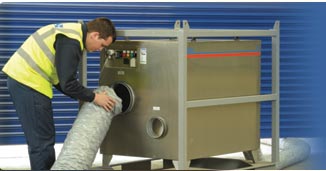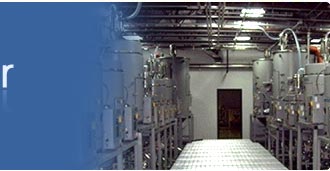WHEN MOISTURE IS TORTURE
Simple & Cost effective Drying using Dehumidifiers
The problems related to product drying are typically:
Quality of Drying & Speed of Drying. Normally products are dried with
hot air. However most products which require drying are temperature
sensitive.
Moisture is present in the products as:
- Free moisture in form of surface moisture generated due to
washing or mixing the product with water prior to drying
- Hygroscopic moisture which is held within the product
- Combination of both
|
Drying operations involve the removal of all moisture to the
required level. Surface moisture (and it is often assumed that it is only
type of moisture present) is conventionally removed by raising the product
temperature by using hot air to vaporize the moisture. However this can
result in product spoilage as many products like cocoa, gelatin, coffee etc
are temperature sensitive and need to be dried at low temperature.
Proper removal of the hygroscopic moisture depends on the difference
between the relative humidity of the air surrounding the product and of the
product’s equilibrium condition. If the RH of surrounding air is lower,
then the product will give up its hygroscopic moisture to the drier air to
be in equilibrium with its surrounding velocity of the air over the product
have little or no bearing on the drying speed?
Product Drying application are typically :
- Bulk (Batch) drying when material is loaded into a
compartment and entire load is dried as a batch.
- Continuous drying is when the wet material continuously is fed
into the drying room/chamber and it leaves the chamber, dried to the
desired result.
|
As every material has different physical characteristics, which determine
how it holds or gives up moisture, and published data on their drying is
generally not available, selecting appropriate air-drying equipment must be
done experimentally.
Usually the sudden change in drying rate (at the critical point) donates
where the initial drying via removal of free moisture ends, and hygroscopic
drying takes place over. In other words, the product has lost its free
moisture but is still hygroscopic ally saturated. However the net effective
drying surface and hygroscopic properties cannot be determined in any other
way.
Advantages of Using Dehumidification over other methods
Dehumidification is the most cost effective and easy method to ensure
drying without spoilage as the drying is based on the difference in vapor
pressures of water in the product and the surrounding air. By physically
removing the moisture from air, through the condensation the evaporative
potential of the air is maximized.
- Better quality drying with more uniform drying
- Faster drying rate without the risk of product spoilage
- Reduction in need for drying
- Low power consumption
|
Environment Drying
Some applications demand reduction of Humidity form the atmosphere of the
Room, Cabin, Hall & Buildings. Certain critical electronic components,
Server Rooms, Laptop, Digital Photocopiers and machinery behave adversely
due to high humidity. During summer the humidity reduces upto 65% with the
help of air conditioning but during the monsoon and during the winters the
solution can be achieved only by Dehumidification. Typically server rooms if
placed in basements are prone to high humidity. Welding electrodes if stored
must be stored in humidity between 40-50% but if humidity increases it
adversely affects the product quality.
Packing for export shipment needs dehumidification especially in cases for
Leather, Surgical Blades, Ball Bearings, and Food items, Electronics etc.
Due to humidity present in the atmosphere the product packed has the high
content of moisture in the packed shipment. During the transit period this
affects the material and we find mould on leather and rusting layers on
metals.
Even in large offices during rainy season the humidity is required to be
reduced rather than reducing the temperature. But often we use air
conditioning to reduce the humidity whereby reducing the temperature to a
very uncomfortable range and also spending excessively on electricity.
Dehumidification improves air quality and efficiency in commercial area and
also dehumidification helps the asthmatic patents.
Corrosion Problems
Corrosion on any metal starts easily when humidity level increases above
45%.The material stored to restricted humidity below 45% can be retained in
good condition. The speed of corrosion is faster, when surface are exposed
to pollution air in combination with high relative humidity. A little water
removal form the air saves a lot of money, material and reputation.
Dehumidifiers are an answer to controlling moisture in packing, warehousing
and storage area. There are basically two types of corrosion :
Inorganic Corrosion : Rusting of metal surfaces.
- Aircrafts/Engines
- Ships/Tanks
- Automotive Parts/Precision Parts/Ball Bearings/Surgical Blades
- Electronic components storage/PCB’s/IC’s
|
Organic : Mould, mildew, funguses or any bacterial growth.
- Museums/Library/Archives
- Leather
- Cheese
- Audio/Video/Film/Micro Film
|
Humidity Control in Indoor Swimming Pools: Indoor swimming pools require a
Rh level of 40-60% for building safety, comfort and energy consumption. Any
much variation beyond 40-60% Rh would generate level of bacteria, viruses,
fungi and algae which leads to poor air quality. For swimmers 50-60%RH is
most comfortable. High Relative Humidity are destructive to building
components and mould & mildew can attack floor, walls,& ceiling
coverings. Generally indoor pool air is maintained appx.1 to 2Deg Cel above
the pool water temperature(but not above threshold of 30Deg C) to reduce the
evaporation rate and avoid chill effect on swimmers.
Areas of where Dehumidification is necessary :
Manufacturing of Honey, Spices, Noodles, Pasta, Walnut, Mushroom, Chillies,
Starch, Dryfruits, Cardboard Box, Soaps, Tobacco, Wood, Flowers, Ceramic
Tiles, Carpet, Medicine, Surgical Blades, Coffee/Tea Vending Machine Powder,
Pharmaceuticals and many more. Packing section for all the above items
including surgical blades, electrodes, medicine, Pharmaceuticals units and
many more. Residences, Offices, Basements, Server Rooms, Wood seasoning
Units, Wood Storage, Hospitals, Restaurants, Swimming Pools, Ice Skating
Areas, Cold Rooms, Cold Storage, Printing Units, Powder Coating Plants, Art
Gallery, Painting Booths, PAINTING OF WALLS / FLOORS etc.
Laser Eye Surgery Rooms
Laser treatment is extremely popular today ,to prevent deterioration in eye
condition and occasionally to cure it.
Moisture Problem: Environmental variables like humidity & temperature
can affect eye surgery results. Research show that eye surgeries performed
in the hottest and most humid months(typically (April, May June) require
more corrective procedures later, when compared to surgeries done during
other months. Uncontrolled humidity in the laser surgery rooms lead to
various problems like:
- Laser strength reduction: Moisture in the air decreases the laser
energy absorbed by the stroma, the thickest layer of tissue in the
cornea.
- Also some patients cornea may become hydrated before the
procedure, making it more difficult for the laser to remove the
tissue.
- Higher the humidity ,lesser the affect of the laser.
|
A 10% increase in treatment room humidity meant an additional nine out of
100 patients require an enhancement procedure. To avoid these problems, the
RH inside the eye surgery rooms should be maintained around 40% Rh at 20Deg
Cel.
Chocolates, Chewing Gums, Bubble gums, candies contain a large percentage
of sugar /sugar based ingredients which are hygroscopic in nature. When
humidity increased these products regain Moisture and become sticky and
prone to mould formation. This inhibits the natural flow as it sticks to the
high speed processing and packing machinery and also to the wrapping
material.
Uncontrolled humidity/moisture during the manufacturing & coating
process of confectionary causes
- Change in the structure/dimensions of the film core interface.
- Grainy and irregular coating.
- Increase in residual moisture content and improper adhesion ie:
degradation of coating quality presence of moisture.
- Sugar bloom and change in flavor.
|
Chocolates need to be stored at 35+5% RH at 25Deg Cel for safe storage in
order to retain its original flavor and aroma.
SO WHAT ARE YOU WAITING FOR HIRE A DE-HUMIDIER FROM AUTOMOTIVE
SOLUTIONS



![]()

![]()
![]() Our
Supply Network - Spread Over PAN India
Our
Supply Network - Spread Over PAN India